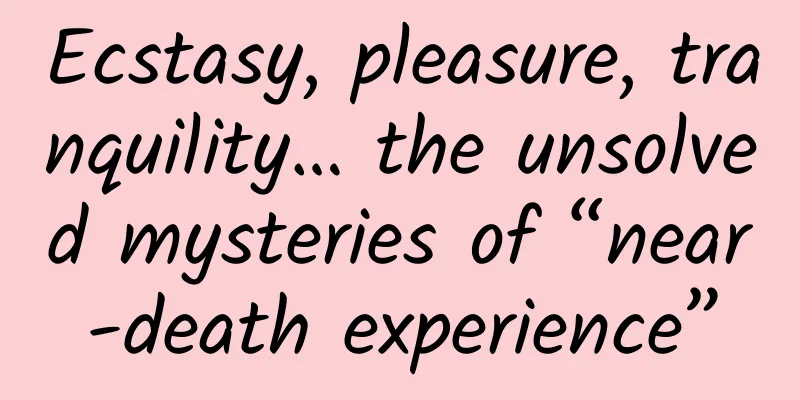Ecstasy, pleasure, tranquility… the unsolved mysteries of “near-death experience”

|
© Psyche.Co Leviathan Press: The mouse experiment mentioned in the article was conducted by Jimo Borjigin, an associate professor in the Department of Molecular Integrative Physiology at the University of Michigan, and his team in 2013. The experiment found that when mice were on the verge of death, their brain waves decreased in amplitude after cardiac arrest, but their frequency increased. From this, they inferred that this might explain why the phenomenon of "Realer than real" appeared when they were on the verge of death. Although some experts believe that the near-death experience of mice cannot be simply equated with that of humans, the experiment does provide scientific basis for the near-death experience (in 2015, Jimo Borjigin also conducted a follow-up mouse asphyxiation experiment. She found that after the mice's oxygen source was cut off, their heart function dropped sharply, but the neurotransmitters related to consciousness in the brain soared). (www.ncbi.nlm.nih.gov/pmc/articles/PMC4413312/) In any case, the ecstasy, joy, and calmness in near-death experiences remain a mystery. Although neuroscientists have determined that this experience is related to abnormalities in the insula, why the brain produces such an experience before death remains to be further studied in the future. Brief description: Severe life-threatening illnesses or conditions, such as heart attack, shock, blast/blunt trauma from falls, etc., often trigger near-death experiences. Most near-death experiences are similar: pain disappears, light is seen at the end of the tunnel, the soul leaves the body, floats above the body, or even flies into the universe. Why does the brain, which is trying hard to keep the body running, not panic but instead produce a positive sense of well-being when it is deprived of blood and oxygen? This question remains unanswered. “Death is easy,” Ernest Hemingway wrote to his family in a letter after he was seriously wounded in a bombing during World War I as a young man. “I have looked death in the face and I know death. To me, death is the simplest thing.” Hemingway (1899-1961), circa 1950. © The Telegraph Years later, Hemingway adapted his near-death experience—the spirit leaving the body, soaring into the air, and returning to the body—into his famous short story, “The Snows of Kilimanjaro,” which revolves around a disastrous African safari in which the protagonist, afflicted with gangrene, knows he is about to die. But suddenly, his pain disappears, and the pilot, Compie, arrives to save him. The two take off, fly through a storm that "looks like a waterfall," and then burst into light: before them, "the top of Kilimanjaro was incredibly white in the sun. Then he knew he had found his home." This passage contains all the classic elements of a near-death experience: being in darkness, the pain disappearing, bursting into light, and then returning to peace. An incomprehensible calm The triggers of a near-death experience include blunt trauma, heart attack, suffocation, shock, and other life-threatening illnesses or conditions. One in ten cardiac arrest patients in hospitals have a near-death experience. Thousands of people who have escaped this pain and suffering have reported being separated from their injured bodies and entering a realm beyond their daily existence, where the boundaries of time and space could not hold them back. This powerful and mysterious experience has changed their lives forever. Near-death experiences are not fantasies. They generally include: the disappearance of pain, seeing a light or other image at the end of a tunnel, leaving the body and floating above it, or even flying into the universe (i.e., an out-of-body experience). © The Institute for Spirituality and Health They may encounter loved ones, living or dead, or spirits such as angels; they may have Proustian memories, even looking back on their ups and downs ("My life flashed before my eyes like a revolving lantern"); or they may have a distorted perception of time and space. Some of these phenomena can be explained physiologically, such as tunnel vision caused by reduced blood flow to the peripheral retina, which means that peripheral vision is the first to be lost. Near-death experiences can be positive or negative. But the media focuses more on the former because it makes people feel a sense of something grand, something supernatural and sacred. The physical trauma is separated from the spiritual peace and feeling of being one with the universe. However, not all near-death experiences are pleasant - some are terrifying, filled with intense fear, pain, loneliness and despair. The publicity surrounding NDEs may have set expectations about how people who experience them should feel. In fact, many people who have had painful NDEs may not report them in order to fit the stereotype that NDEs are "pleasant" due to shame and social stigma. Any near-death experience reminds us of the fragility and uncertainty of life, while also breaking down certain psychological barriers that might otherwise keep us from thinking about the end of our lives. In most cases, people forget these experiences over time and eventually return to normal (some may also develop post-traumatic stress disorder). But decades after a near-death experience, memories of it can come back with unusual intensity and clarity. In 2017, two researchers at the University of Virginia asked a question: Could the paradoxical combination of reduced brain function and enhanced cognitive abilities during near-death experiences be explained by a leap in imagination? Researchers gave 122 people who had near-death experiences a questionnaire. They asked the subjects to compare their near-death experiences with real events that happened around the same time and with fictional imaginations. The results showed that the memories of near-death experiences were more vivid and detailed. In short, in people's memories, near-death experiences were "more real than reality." (med.virginia.edu/perceptual-studies/wp-content/uploads/sites/360/2017/03/NDE-85-MCQ-ConCog.pdf) © Brian Stauffer NDEs came to public attention in the last quarter of the 20th century, thanks to the work of doctors and psychologists, particularly Raymond Moody, who coined the term “near-death experience” in his 1975 bestseller Life after Life, and Bruce M. Greyson, one of the two researchers mentioned above, who published The Handbook of Near-Death Experiences in 2009. Noting the commonalities in the NDEs people shared, these researchers brought visions that had once been laughed off as delusions or mistaken for fever into the realm of empirical research. I believe these strong feelings are real. They are as real as any other subjective feeling or perception. However, as a scientist, I work under the assumption that all thoughts, memories, perceptions, and experiences are the natural and inevitable result of the power of the brain, and not from any supernatural agency. This has been the premise of science and its auxiliary power, technology, for the past few centuries. Unless there is extraordinary and compelling objective evidence to disprove it, I see no reason to abandon this assumption. The challenge, then, is to explain near-death experiences within the confines of natural science. Having long studied mind-body problems, I am particularly interested in near-death experiences, which not only constitute a rare type of consciousness, but can also leave a lasting impact on people in just an hour, causing them to change their beliefs, no longer fear death, and detach from material desires to pursue greater goals. Or, as in the case of Hemingway, become obsessed with adventure and death. © Buy Research Chemicals People have similar mystical experiences after taking psychoactive substances from a class of psychedelic drugs that affect the neurotransmitter serotonin, such as psilocybin, LSD, DMT, and 5-MeO-DMT, which are often used in certain religious, spiritual, or recreational activities (please strictly follow local laws and regulations). Unknown City We must remember that near-death experiences have been present in all cultures and among all groups, young and old, devout and skeptical (think of the so-called Tibetan Book of the Dead, which describes the spiritual world before and after death). Whether Christian or other religious people, the most likely explanation for their near-death experiences is that they have been indoctrinated with the idea of going to heaven or hell and reincarnation after death. Interestingly, nonbelievers and those who have abandoned their faith are no less likely to have near-death experiences than devout believers. In the historical record, personal accounts of near-death experiences are as vivid as those of dry clinical case reports. For example, in 1791, British Admiral Sir Francis Beaufort (for whom the Beaufort wind scale is named) described his near-death experience as follows after nearly drowning: A sense of deep peace overcame the most frantic sensations... The physical pain was gone. On the contrary, I felt a sense of joy... Although the senses were numb, the mind was not. It was active to an extent that cannot be described. My thoughts were so rapid and continuous that it would be difficult to describe and perhaps unbelievable to an outsider. To this day, I can still clearly recall the process of my thoughts: starting with what had just happened... and moving backwards, each past experience flashed before my eyes in reverse... My entire life seemed to be in front of me. Here’s another example. In 1900, Scottish surgeon Sir Alexander Ogston (who discovered Staphylococcus) came down with typhoid fever. He described his experience this way: I lay in bed, seemingly in a stupor without hope or fear. My mind and body seemed to be somehow separated. I realized that my body was like a bulky piece of junk by the door, it belonged to me but did not constitute me. My spiritual self often left my body... and then was quickly pulled back, merged with the body in disgust, became me again, fed, talked to, cared for... Although I knew that death was hovering around me, I did not resort to religion, nor did I fear death. I just walked under the dark sky, indifferent and content, until something disturbed my body again and I had to be pulled back again. Here’s a more recent example. British writer Susan Blackmore received a report from a Cypriot woman who had an emergency gastrectomy in 1991: On the fourth day after the operation, I went into shock and was unconscious for several hours... Although I was pronounced unconscious at the time, I still remember every word the surgeon and the anesthesiologist said many years later... I floated above my body, without any discomfort, just looking down at my painful cheek with pity; I floated peacefully. Then... I had to go somewhere else, to a dark but not scary place... Then, I felt completely peaceful. Suddenly, everything changed - I was slammed back into my body and felt the pain clearly again. It's hard to know exactly what neurological activity leads to a near-death experience because the brain can be damaged for a variety of reasons, and near-death experiences don't occur while a person is lying in an MRI scanner or with electrodes covering their scalp. But we may be able to gain a better understanding of near-death experiences by studying people who have had a cardiac arrest (or, in medical parlance, are being "restarted") but who are not dead and whose hearts can be restarted with cardiopulmonary resuscitation. Today, the definition of death includes the permanent loss of brain function. When the brain is deprived of blood and oxygen, the patient collapses within 60 seconds and the electroencephalogram (EEG) becomes isoelectric—in other words, it flattens into a straight line. This means that in the cerebral cortex (the brain's outermost layer), large-scale electrical activity has stopped everywhere. Just like a town losing power block by block, local areas of the brain are shutting down one by one. But the mind continues to function, supported by neurons that have not stopped firing: telling stories in the mind based on personal experiences, memories, and cultural expectations. In the case of a "power outage", such experiences may become strange and special stories in near-death experiences. For those who have experienced it, the near-death experience is as real as anything the brain perceives in the waking state. When the entire brain collapses due to a complete "power outage", thinking and consciousness disappear. Once there is sufficient blood and oxygen, the brain will restart and resume daily functions. Scientists have recorded, analyzed and carefully studied the cases of people who have undergone intensive training, such as American test pilots and NASA astronauts who were trained in centrifuges during the Cold War, and the process of losing and gradually regaining consciousness, which reminds us of the 2018 movie "First Man", in which Ryan Gosling played the tenacious Neil Armstrong who kept spinning in a multi-axis training machine until he fainted. Under the influence of about 5 times the gravity, the cardiovascular system can no longer supply blood to the brain, and then the pilot will faint. When this hypergravity stops for about 10 to 20 seconds, they will regain consciousness, but their thinking and sense of direction will be very confused for a period of time (the participants in the test are physically fit and proud of their strong self-control). The phenomena they describe may be a "simplified version" of near-death experiences - tunnel vision and bright lights; feeling like you are waking up from a sleep with partial or complete paralysis; floating peacefully; out-of-body experiences; extreme happiness or even ecstasy; short but impressive dreams, such as frequent dreams of talking to family members, which are still vivid when recalled many years later. These intense sensory experiences are triggered by specific physical traumas and are usually not influenced by religion (this may be because the participants already knew that they would be subjected to continuous high pressure until they fainted). The very nature of near-death experiences has prevented them from being studied in carefully controlled labs, but that may be changing. For example, it may be possible to study some aspects of the phenomenon in mice—perhaps they too reflect on their lives or feel joy before dying. (www.pnas.org/content/110/35/14432) Disappearance of light Many neurologists have noted similarities between near-death experiences and complex partial seizures in epilepsy. These seizures cause loss of consciousness and occur in a specific area of one hemisphere of the brain. They are preceded by auras, and the patient may experience a characteristic premonition. People with epilepsy may lose the ability to perceive the size of objects, have abnormal taste, smell, or body sensations, experience déjà vu, have depersonalization symptoms, or experience ecstasy. In clinical practice, epilepsy characterized by ecstasy is also called Dostoyevsky's seizures, named after the late 19th century Russian writer Fyodor Dostoyevsky, who suffered from severe temporal lobe epilepsy. In his novel The Idiot, the protagonist Prince Myshkin recalls: There were always one or two moments when he felt that his whole heart, his whole brain, his whole body seemed to awaken in vitality and light, when he was filled with joy and hope, and all his anxieties seemed to be swept away and ended forever; but this was the last second before the epileptic seizure, indicating that the epileptic seizure would come immediately, not a second later. That moment was certainly indescribable. After he recovered, the Duke often said to himself when he recalled the symptoms: "... Although it is a disease, an abnormal spasm of the brain nerves, what does it matter? When I recall and savor these moments, it seems to be the highest harmony and beauty - in the deepest feeling of that moment, there is infinite joy and ecstasy, ecstatic piety and even the most perfect life. I would like to devote my life to this moment." More than 150 years later, neurosurgeons were able to induce feelings of ecstasy in epileptic patients by implanting electrodes to stimulate a cortical area called the insula. This helped locate the epilepsy lesion in preparation for possible resection. Patients reported feelings of ecstasy, happiness, and increased self-awareness or awareness of the outside world. Stimulating gray matter in other areas of the brain can also cause them to have out-of-body experiences or visual hallucinations. (pubmed.ncbi.nlm.nih.gov/31196836/) © Virtual Psych Centre Whether the seizure is caused by a spontaneous disorder or triggered by a surgeon’s electrodes, the straightforward link between the abnormal neural activity pattern and the subjective experience suggests that the sensation is biological rather than caused by a supernatural agent such as the soul. The same may be true for near-death experiences. Why does the brain experience the struggle to maintain function as a positive, blissful experience when losing blood and oxygen, rather than feeling fear? We still don't know the answer. But interestingly, humans also experience extremes in other situations. For example, when diving, climbing mountains, flying, playing suffocation or fainting games, reduced oxygen can make people feel happy, dizzy, and highly excited. Perhaps many forms of death involve this state of ecstasy, provided the mind is clear and not paralyzed by opium or other drugs designed to dull pain. Before entering what Hamlet calls "the undiscovered country from whence no man returns," the mind, bound by the dying body, visits its own version of heaven or hell. By Christof Koch Translation/antusen Proofreading/Yord Original article/www.scientificamerican.com/article/what-near-death-experiences-reveal-about-the-brain/ This article is based on the Creative Commons License (BY-NC) and is published by antusen on Leviathan The article only reflects the author's views and does not necessarily represent the position of Leviathan |
>>: Where does blood come from and where does it go?
Recommend
You can stand guard and take care of babies. It turns out you are this kind of mongoose!
Do you still remember this photo? In the previous...
BYD Financial Report: BYD's operating income in 2023 will reach 602.315 billion yuan, a year-on-year increase of 42.04%
BYD released its 2023 annual report. In 2023, BYD...
Xiaohongshu competitive product analysis report!
Today, when e-commerce has penetrated into our li...
One article is enough for the year-end marketing plan of wine promotion
How to promote alcoholic products? An article wil...
What does the 13-story Wenchang Tower represent?
Wenchang Tower is divided into 7, 9 and 13 floors...
Weijing TV startup experience: idol-like performance
Last week, we conducted a violent evaluation of t...
Tavistock short-term dynamic therapy twelve-lecture online course complete set of materials
Tavistock Short-Term Dynamic Therapy 12-Lecture O...
What are the specific circumstances under which the Hubei government will provide assistance to people stranded in other places? Who can get assistance?
As we all know, the origin city of this epidemic ...
The State Administration of Radio, Film and Television interviewed the license holders and stressed the need to strictly punish cross-border behavior
According to sources, the State Administration of...
I bought a TV for 2700, but it costs 4600 to replace the screen. The home appliance repair assassin, the manufacturer cannot shirk responsibility
In recent years, "assassin" has become ...
Apple fans have been posting a lot of comments on VoLTE on their WeChat Moments. What exactly is it?
Some time ago, Apple and China Mobile pushed an op...
Can eating snacks help you lose weight? The premise is that you have to do these 4 things!
Snacks include not only fruits, nuts and potato c...
What creative elements are there in the hot copywriting for the Winter Solstice?
At 0:28 on December 22, 2017 (Friday), we will us...
South Korea added 147 new confirmed cases of COVID-19 yesterday, bringing the total to 8,799!
[South Korea added 147 new confirmed cases of COV...









